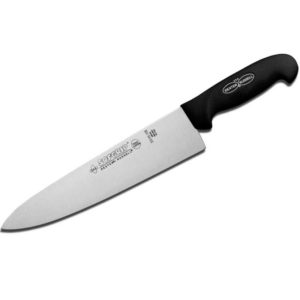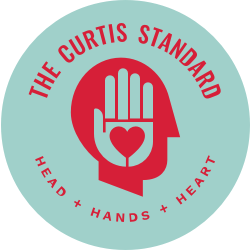At Curtis Restaurant Supply, we have the commercial cutlery you need. No matter which knife you buy you can rest assured we have chosen each knife for it’s quality and performance. With the proper care, your new knife can serve you for years to come.
Thank you to Chef Lisa from Chrane Foodservice Solutions who represents the Dexter line of knives for this valuable information explaining the different types of knives available, basic safety tips, and how to care for your most used kitchen tool.
 The Parts of a Knife
The Parts of a Knife
1. POINT- the piercing tool of the blade; used to begin the cut.
2. TIP- forward quarter of the blade, used for many cutting tasks; best used for cutting smaller foods and cuts.
3. CUTTING EDGE- the working part of the blade, from point to heel. The central part of knife cuts virtually all foods using long, rocking or slicing motions.
4. SPINE- the edge opposite to the cutting edge.
5. HEEL- rear part of the cutting edge; used to cut through larger and tougher foods when weight and force is needed.
6. BOLSTER- thick steel band present on forged knives; helps balance knife and protect from accidental slips.
7. TANG- part of the blade that extends into the handle designed to give the knife its balance.
8. SCALE/HANDLE- section of handle that is commonly gripped; generally made from wood or plastic.
9. BUTT- end of the knife.
While hundreds of knife styles, sizes and designs are available, most kitchen tasks can be accomplished with three essential knives; a chef’s knife, a serrated knife, and a paring or utility knife. When purchasing any knife, it’s important to look at several styles, handle designs, lengths, and weights. The best knife for you will feel like an extension of your hand, with natural-feeling grip, good balance, and a comfortable weight. Try holding several knives, and practice cutting with them before making any purchases.
In general, there are two broad categories of chef’s knives, Western and Japanese. Western knives tend to have thicker, heavier blades, and their edges are ground to a wedge shape with an angle of around 20 degrees on each side. These types of knives are good for heavy-duty cutting tasks, such as slitting tough or fibrous vegetables, or bones. Japanese knives often feature thinner blades, which are ground on one side at an angle around 15 degrees. The thinner blade and steeper angle makes Japanese knives suitable for finer and more delicate cutting and slicing tasks.
Below are descriptions of the different types of common kitchen knives, as well as things to keep in mind when purchasing knives:
Chef’s Knife – an all-purpose kitchen knife, used for most types of chopping, dicing, mincing, and slicing tasks. They are typically available in 6”, 8”, 10” and 12” inch lengths. The length you choose will depend upon the weight and size of knife you prefer.
Serrated Knife – a knife with a sharp edge and saw-like teeth. The blade of a serrated knife is normally 5”-10” in length. Due to their irregular edge, serrated blades are typically sharpened by a professional sharpening service. A serrated knife with a long blade is used to slice through food with a harder outer surface and softer interior, such as a loaf of crusty bread. A serrated knife with a short, thinner blade is typically used for slicing small fruits and vegetables.
Paring Knife – a small knife with a 3” to 4” inch long blade. It works well for delicate tasks, and for peeling and coring foods, such as apples. The blade is typically thin and narrow. And tapers to a point at the tip of the knife.
Utility Knife – a small light weight knife with a 4” to 7” inch long blade. It is used for many of the same tasks as a paring knife, plus miscellaneous light cutting tasks, such as fruits and vegetables and slicing sandwiches.
Carving Knife – a knife with an 8” to 15” inch blade, used for carving large roasts, poultry, and filleting large fish. The blade edge of a carving knife is either smooth or sometimes beveled. The blade should be large enough to carve across the cut of meat, poultry or fish in one cut. The blades vary in flexibility. A carving knife with a rigid blade is used for slicing roasted meats, while more flexible blades are used for poultry. The thinnest and most flexible blades are used for slicing smoked fish. Carving knives are most often sold in sets with a carving fork. A carving fork is designed to hold the meat steady while slicing.
Boning Knife – a knife with a thin, short blade, normally 5” or 6” inches long, used to remove the main bone within a cut of meat, such as ham or a beef roast. A boning knife will typically have a long narrow blade for trimming meat around bones.
Filet Knife – a knife with a thin, flexible blade, normally 6” to 11” inches long, used for filleting fish. The narrow blade enables the knife to cleanly move along the backbones of the fish, in and around areas adjacent to bones, and to evenly slice along the skin, removing it easily from the flesh.
Cleaver – a knife with a wide, ridge blade approximately 6” inches in length, which tapers to a sharp cutting edge. It is used to chop, shred, pound, or crush food ingredients.
Santoku Knife – in Japanese, “Santoku” means “three virtues,” referring to the attributes of this all-purpose kitchen knife, which is used for cutting, slicing, mincing, and dicing. The main difference between a Santoku and a chef’s knife is the blade edge. While a chef’s knife features a slightly curved edge, a Santoku has a straight edge. From a cutting standpoint, a chef’s knife is suited for cutting with a “rocking” motion, while the Santoku is best suited for up-and-down cutting and chopping. A Santoku also has a shorter blade, typically 5-7”inches long, in contrast to a longer chef’s knife. In addition, Santoku knives are made with standard-edged blades or a hollow ground edge, also known as a granton edge. The purpose of the granton style blade is to assist with keeping particles from sticking to the edge of the knife. Santoku knives are a good choice for people with smaller hands, who also like a lighter-weight knife.
Knife Construction
Kitchen knives are manufactured using several different processes and materials. The best quality knives are forged, meaning the knife material is heated and hammered. A good quality knife will also feature a tang that-extends through the entire length of the handle, as well as a bolster that is an integrated part of the blade.
Other knives are often stamped, or cut from sheets of metal using a die or stamp. They often feature plastic handles, and are less expensive than forged knives. When selecting a knife, consider the amount of time you spend in the kitchen, the types of cutting tasks you most often perform, and how much time you want to devote honing and sharpening.
Knife blades are made from a variety of metal alloys, or combinations, to achieve a balance between blade hardness, toughness, edge retention, corrosion resistance, and sharpness. Below are some common knife blade materials found in kitchen knives.
Carbon Steel – carbon steel has been used in the making of blades for many years. Carbon steel blades can be sharpened to a very fine edge, and can be sharpened with relative ease. Carbon steel blades discolor when they come in contact with foods that are high in acid, such as tomatoes and citrus. These blades must be treated with care to avoid discoloration and rusting. Wash and dry very thoroughly after each use.
Stainless Steel – stainless steel blades are easy to care for, since they resist rusting and discoloration. Due to the materials hardness, they maintain a sharp edge longer than carbon steel but are more difficult to sharpen.
Knife Safety
Knife safety is important in every kitchen, from professional to home. Below are a few simple guidelines for using kitchen knives safely.
- A sharp knife is a safe knife. By trying to force a dull knife through a piece of food, the knife is much more likely to slip and cause an injury.
- Never, grab a falling knife. Always make sure your knife is placed securely on your work surface at all times. If a knife happens to fall, resist the natural urge to grab it.
- Always cut on a cutting board. Cutting boards made from wood products and plastic help reduce wear and tear on a knife’s edge. Never cut on glass, marble, or metal surfaces, which dull and damage knives.
- Secure your cutting board. If your cutting board doesn’t have rubber grips, place a moistened paper towel underneath it to keep it from sliding or shifting during cutting.
- Always cut away from—never towards—yourself. Position your hands and knife so to you draw the knife away from you while cutting.
- Keep your eyes on your knife while using it. Often, injuries happen when you look up from your cutting task. Stay focused on the knife relative to your hands during all cutting tasks.
- Carry a knife safely. If you’re walking with a knife, carry it pointed straight down, with the blade towards your thigh.
- Never put a knife in a sink full of water. Placing a knife in a sink full of water is a potential hazard for you and others, plus it can damage wooden knife handles. Always wash kitchen knives by hand, wipe them dry, and store safely.
- Fine quality kitchen knives should never be cleaned in the dishwasher, since the high temperatures and abrasive cleaners can damage both the knife handle and blade.






Leave a Comment